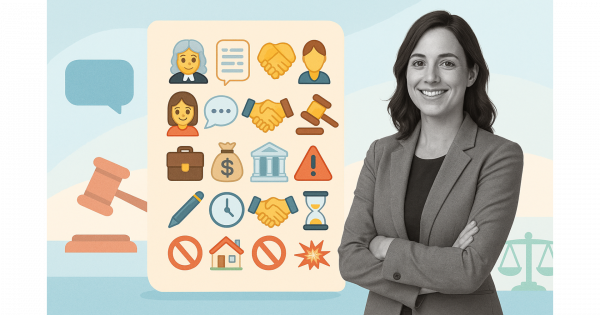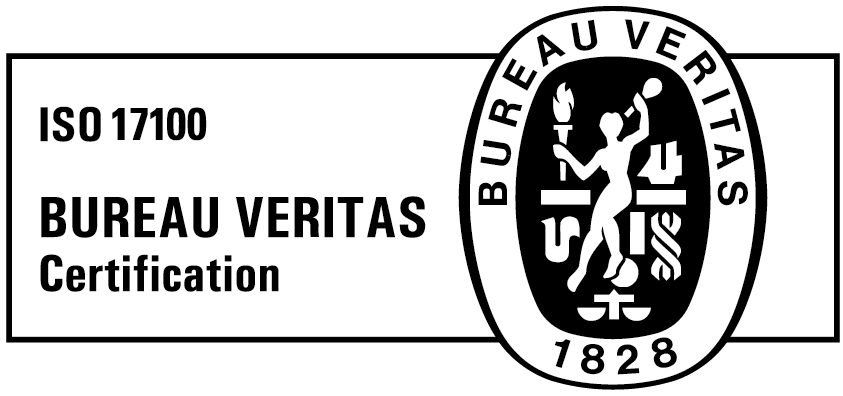-
Eva Legovic
- May 20, 2025
- 7:42 am
- Estimated reading time: 10 minutes
-
Eva Legovic
- May 20, 2025
- 7:42 am
- Estimated reading time: 10 minutes
What is legal translation?
Legal translation is the process of converting legal documents from one language to another — accurately, clearly, and with the same legal meaning.
It’s how businesses protect themselves when expanding into new markets, negotiating international contracts, or updating multilingual privacy policies.
According to CSC’s General Counsel Barometer 2024 study, 31% of global-ready, multinational companies report challenges with local privacy laws and jurisdictions, while 26% say they’re not confident in their ability to verify data across borders. In short, scaling internationally is as much a legal challenge as a business one.
And it’s not just internal legal teams sounding the alarm. According to Procloz, 70% of companies encounter legal or compliance issues when entering new markets — many due to misaligned policies, misunderstood documentation, or inconsistent translations. These aren’t just paperwork problems. They’re operational risks.
When your contracts, policies, and regulatory documentation can’t travel as fast as your business does, progress stalls.
Despite what search results might suggest, most legal translation doesn’t involve court filings or sworn translators. For everyday business documents — like NDAs, privacy policies, or internal HR policies — what you need is accuracy, consistency, and a reliable process. Not a rubber stamp.
In this guide, we’ll cover:
- Which types of legal documents require translation
- When certification is necessary — and when it’s not
- How AI-powered tools like Taia help you translate smarter, faster, and more affordably
Which legal documents need translation?
If your company operates in more than one country, you’re already working with content that needs to be legally sound in multiple languages. Legal translation isn’t limited to courtroom evidence or notarized statements, but it’s about the everyday documents that keep your business moving.
We’re talking about:
- contracts and service agreements
- NDAs and partnership terms
- privacy policies and cookie notices
- terms and conditions
- compliance and regulatory documents
And one area companies often overlook? Internal HR policies, onboarding materials, or whistleblower procedures — all of which may need to align with local labor laws and regulatory standards. We’ve seen these create major bottlenecks in cross-border expansions, especially in the EU.
These documents often contain specialized legal terminology that must be translated with total precision. A mistranslated clause or vague phrase doesn’t just confuse — it can lead to regulatory fines, lawsuits, or reputational damage.
That’s why translating legal documents demands more care than general business content. You’re not just translating — you’re preserving legal weight, intent, and enforceability in another language. Whether it’s a partnership agreement or a privacy policy, well-translated legal documentation protects your business the same way the original does.
There’s no room for ambiguity when legal responsibility is on the line.
Why accuracy matters in legal translation?
Surely you have a feeling why, but let’s write it in stone – legal translation is about liability. A single mistranslated clause in a contract, a vague sentence in a privacy policy, or an imprecise term in a compliance document can expose your company to serious legal risk. And unlike marketing copy or product pages, legal content doesn’t allow for interpretation or creativity. There’s one right version — the one that holds up in court.
This is where legal language translation becomes especially complex. Laws differ from country to country, and the same term can carry completely different implications. A phrase that’s enforceable in one jurisdiction might be meaningless — or even dangerous — in another.
We once reviewed a translated service agreement where “terminate without cause” had been rendered as “terminate at will.” It sounded close — but legally, it wasn’t. That subtle shift could’ve invalidated the clause in several EU countries. This kind of risk is exactly why we embed legal-aware quality assurance into all high-impact content.
That’s also why legal translation can’t rely on general-purpose tools or freelancers without legal expertise. Even AI systems need the right training, legal glossaries, and translation memory to be effective — and they must be backed by expert review.
At Taia, we combine adaptive AI with trained legal linguists to ensure accuracy, consistency, and compliance at scale. Because in legal translation, “good enough” just isn’t good enough.
When should your legal translation be certified?
Certified translation sounds official — and it is. It usually means the translation has been completed or verified by a sworn translator who can legally attest to its accuracy. In many countries, this level of certification is only required for very specific use cases: court filings, immigration paperwork, or official records like birth certificates and academic transcripts.
The thing is, legal translation of documents for business generally doesn’t need certification.
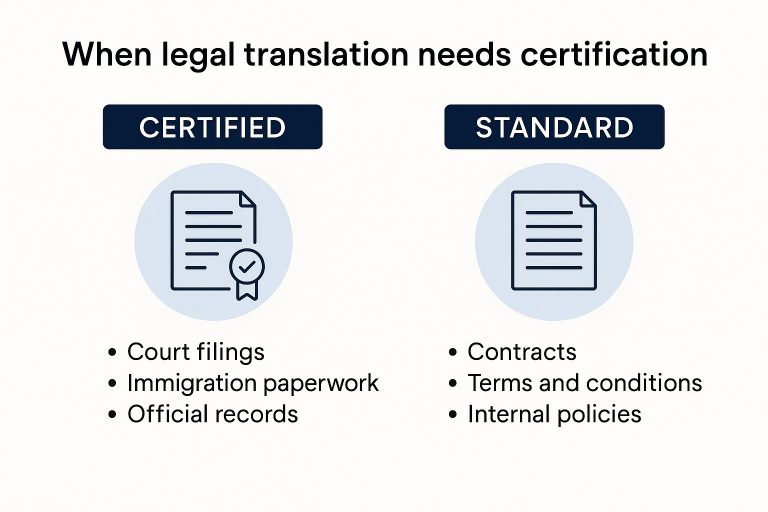
If you’re translating contracts, terms and conditions, NDAs, or internal policies for your company’s operations, a standard legal translation — done with accuracy and subject-matter expertise — is more than enough.
That’s where the right setup makes all the difference: a smart translation tool, supported by a professional team. Taia’s AI-powered legal translation system is built exactly for this — combining speed and cost-efficiency with expert oversight when needed. You get high-quality translations for contracts, policies, and compliance documents, without paying for certification you don’t actually need.
If certification is ever required, it should be clear from whoever is requesting the document. But in most cases? A well-executed legal translation is all you need — and it gets the job done faster.
How AI translation tools handle legal content?
Legal translation demands precision. But it also demands speed — especially when you’re dealing with frequent updates, last-minute contract changes, or multi-market compliance deadlines. That’s where AI-powered translation tools can deliver real value.
Modern legal translation software, like Taia’s AI Translator, is trained on real legal data on the basis of your translations. It recognizes recurring patterns, understands terminology in context, and can apply your company’s preferred terms using built-in glossaries and translation memory. That means faster turnaround times without sacrificing accuracy.
Here’s how it works in practice:
- AI handles the initial translation — fast and cost-effective
- Key terms are locked in using a glossary, so “termination clause” doesn’t become “end rule”
- Optional but highly recommended human review ensures the final version is clean, consistent, and legally sound
- Your existing legal content is reused where possible thanks to smart translation memory
- AI learns from this process and gives back better output each time
Put simply: the more you translate, the more you save.
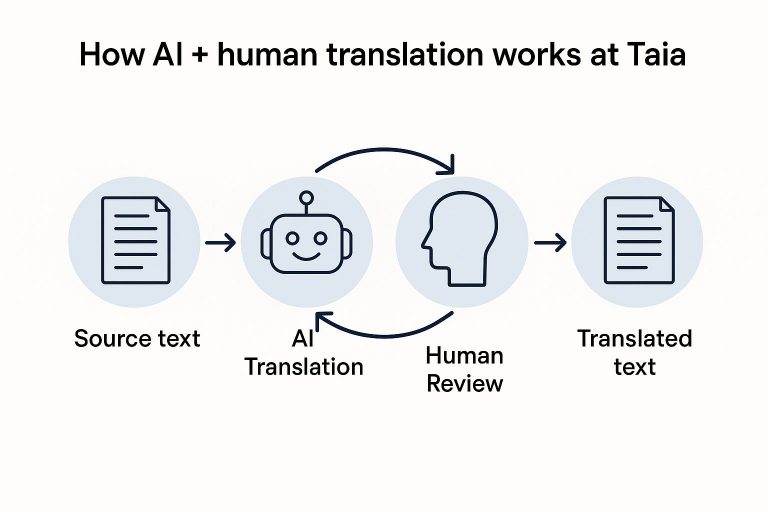
In one project with a global fintech client, we helped reduce turnaround time for compliance document updates by over 60%. How? By setting up domain-specific translation memory and a post-editing loop that let their team scale fast — without sacrificing accuracy.
This kind of hybrid setup makes legal translation both smarter and safer. For high-volume or frequently updated content — think product terms, HR policies, or cross-border contracts — it’s a game changer.
Legal translation best practices for businesses
When it comes to translating legal content, cutting corners can cost you. But that doesn’t mean you need a slow, expensive process either. With the right workflow, you can translate legal documents accurately, efficiently, and at scale.
Here are a few best practices we recommend:
- Segment your content by type and risk level.
Don’t treat a contract the same as a privacy policy or internal HR memo. Group your documents by legal sensitivity and assign the right translation approach — full human review for critical contracts, AI + post-editing for standard policies, and AI-only for internal communication. - Use a glossary and translation memory.
Legal translation is as much about terminology as it is about grammar and clarity. A glossary ensures terms like “limitation of liability” or “data processor” are used consistently across markets. Translation memory speeds things up and keeps recurring phrases accurate. - Build a review loop.
Even the best AI can’t handle the nuances of language, let alone legal. For high-stakes content, always include a legal-savvy linguistic reviewer who can double-check meaning and formatting before anything gets published or signed. - Don’t mix domains.
We recommend companies set up separate translation memories for legal, marketing, and product content from day one. It avoids style bleed and reduces the risk of pulling the wrong match from translation memory.
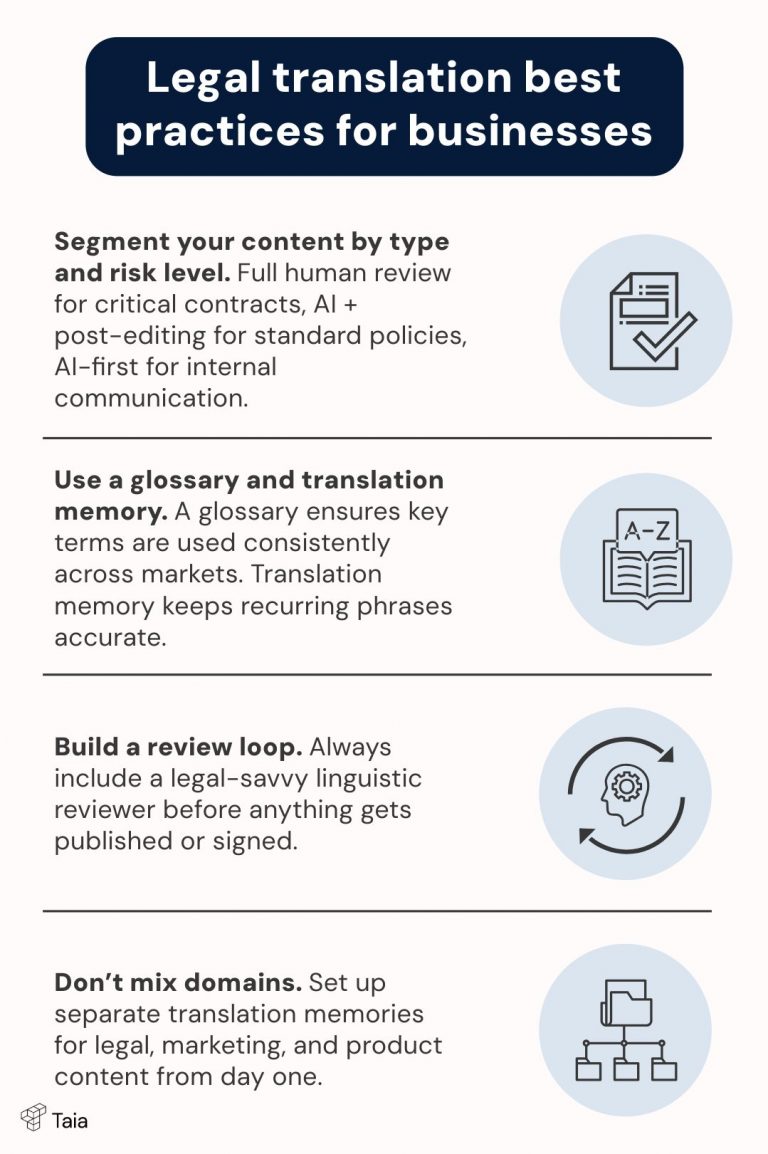
Final thoughts: quality matters — but in business, smart execution matters more
When it comes to legal translation, quality isn’t optional. You’re dealing with content that carries real legal consequences.
But here’s the good news: delivering quality doesn’t mean you have to overspend or rely entirely on traditional, manual processes.
Modern legal translation is about working smarter. With the right tools and workflows — like AI translation backed by legal-aware human review — you can get fast, accurate results without compromising precision or consistency.
At Taia, we’ve helped businesses scale their legal translation needs without losing control over quality. Whether you’re rolling out multilingual contracts or updating terms of service across markets, we make sure every translated document holds up — legally, linguistically, and operationally.
Because in legal translation, it’s not about choosing between speed and accuracy. It’s about building a system that gives you both.
Frequently asked questions
What is the best AI for legal translation?
The best AI for legal translation depends on your specific needs, but Taia’s AI-powered translation services offer a robust solution for businesses. We combine the speed and scalability of AI machine translation with the precision of Translation Memory (TM) and glossary, ensuring your legal documents maintain accuracy over time. For sensitive or high-stakes content, we also provide the option for human review to ensure top-notch quality.
How much does it cost to translate a legal document?
The cost of translating a legal document depends on several factors, including the type of document, length, and complexity. Taia’s AI + human translation services offer a more affordable alternative to traditional human translation, with prices generally ranging from $0.10 to $0.20 per word for standard translations.
What is the difference between legal translation and normal translation?
Legal translation is far more specialized than general translation. While general translation focuses on conveying meaning, legal translation ensures that every term, clause, and phrase is precise and legally binding in the target language. Legal translators must understand both the legal system of the source and target language, as even a slight error in translation can lead to significant legal consequences. Taia’s AI + human translation services are designed to handle legal terminology with high accuracy, and we use Translation Memory to ensure consistency across multiple documents.
Is legal translation hard?
Yes, legal translation is one of the most challenging types of translation due to the complexity of legal terminology, the need for contextual accuracy, and the potential legal implications of any error. It requires in-depth knowledge of both legal systems and a strong command of the target language. While AI translation can speed up the process, it’s crucial that human review is incorporated for high-stakes documents to ensure precision. At Taia, our AI-powered tool helps streamline the process, making legal translation faster and more cost-effective, with human review available with a click
What is legal translation?
Legal translation is the process of converting legal documents into another language while preserving their original meaning and legal effect. It’s crucial for ensuring contracts, policies, and agreements remain valid and enforceable across borders.
What kinds of legal documents need translation?
Typically, these include service agreements, NDAs, privacy policies, terms and conditions, HR policies, and compliance documentation. If a document carries legal weight in another market, it should be translated by someone familiar with legal terminology.
Is AI legal translation reliable?
Yes — but only when combined with human quality checks. Platforms like Taia use AI trained on legal content, then give you the option to add human review. This hybrid approach delivers speed without sacrificing legal accuracy. For example, translating your T&Cs or data protection policies with AI and having them reviewed before launch is a fast, low-risk workflow.
When should legal translation be certified?
Certification is only needed when it’s legally required — usually for things like immigration documents, court filings, or official records. Most business documents don’t need it.
If you’re unsure, reach out to our team and we’ll help you check.
What’s the difference between legal translation and normal translation?
Legal translation requires deep knowledge of legal terms and their context. It’s not just about language — it’s about liability. That’s why general translation tools often fall short here.
Can I translate legal documents myself or with Google Translate?
Not recommended. Legal language is too precise for copy-paste solutions. One mistranslation in a clause could open the door to disputes. Use a legal-grade tool like Taia’s AI Translator with a human review option — built for business-critical content.
Do I need a legal translator or a good translation tool?
The best-performing teams we work with use both: AI for speed, human experts for critical checks. The key is knowing where to draw the line — and we help teams do just that.
How do I know if my legal translation is accurate?
Use a tool that supports glossaries, translation memory, and human review. If you’re translating something high-risk — like a contract or compliance policy — always include a second set of expert eyes.
More for you
Need a fast & reliable document translator?
Stay updated on business translation – subscribe to our newsletter
